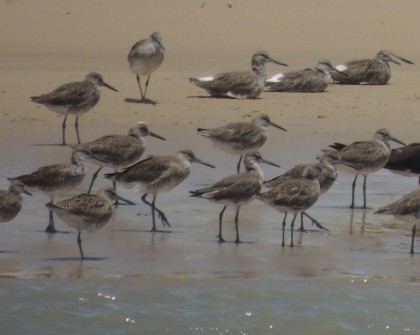
During my recent trip to Brazil, I saw the eastern willet’s winter haunts with my own eyes for the first time. I’ve seen the area countless times on Google Earth as I puzzled over tracking data that led me from their breeding grounds in east coast salt marshes to the mangroves of Maranhão, Brazil, 4,000 kilometers away.
We were working in in one of the exact places that several of our east coast willets appeared to spend the winter. I have pored over my snapshots, checking willet legs for bands in hopes of seeing an old friend from New Jersey with color bands. No luck, but I only saw a fraction of the thousands of willets in the area.
In Brazil, as in New Jersey, the eastern willet is a mud bird. At low tide they spread out on mud flats and forage for fiddler crabs sharing space with whimbrel, black-bellied plover and numerous other shorebirds and waterbirds, including scarlet ibis.
At high tide, like many other shorebird species, willets join flocks at high tide roosts where they wait for the tide to recede. In the sites we saw they roosted among the raised roots of mangrove trees in small flocks.
In addition, we saw one large flock form on the back of a dune where they gathered with their fellow crab-hunters, the whimbrel. This is notable because our intention to catch willet required us to find a spot where we could set a cannon net. You can’t set a net in mangrove roots and it can’t be set in mud very well either. Thankfully this mud bird is willing to at least roost on sandy terrain.
My past work with willets, along with that of the Biodiversity Research Institute and Biodiversity Works, has emphasized the importance of Maranhão for the species because 21 out of 23 birds we tracked from breeding sites in New Jersey and New England spent their eight-month non-breeding period there.
It remains to be seen exactly what proportion of the entire eastern willet population winters in Maranhão and more research there and in other parts of the breeding range will answer this question. It’s an important one to answer because the fate of eastern willet populations may be intimately tied to the fate of their mangrove haunts in Brazil.